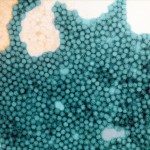Link to Pubmed [PMID] – 2465786
Biochimie 1988 Aug;70(8):1065-73
The hepatitis B surface antigen (HBsAg) has the unique property of assembling with cellular lipids into spherical or elongated particles of 22 nm diameter which are secreted by mammalian cells expressing HBsAg. We have studied the structural requirements for particle formation and secretion by creating in-phase insertions into different regions of the S gene of the hepatitis B virus, coding for HBsAg. Modified genes were integrated into an appropriate vector and expressed in mouse L cells. Various single and double inserts in the two major hydrophilic domains of HBsAg were compatible with particle synthesis and secretion. The level of secretion was influenced by the length of the insert, its primary structure, and the site of insertion into the HBsAg molecule. One of the inserted sequences was a synthetic DNA fragment encoding a continuous type 1 poliovirus neutralization epitope (the C3 epitope). Mammalian cells expressing the modified hepatitis B virus S gene secreted hybrid particles carrying the poliovirus antigen. The hybrid polio-HBsAg particles reacted with a monoclonal antibody specific for the C3 epitope and induced poliovirus neutralizing antibodies at low, but significant, titers in mice and at high titers in rabbits. However, the immune response to HBsAg was weaker to hybrid particles than to unmodified HBsAg particles. By cotransfection with two different plasmids carrying either modified or unmodified genes, we obtained phenotypically mixed particles containing both polio-HBsAg and HBsAg molecules. Inoculated into rabbits, the mixed particles induced high antibody titers against both poliovirus and HBsAg.
